wheel HONDA CIVIC SEDAN 2021 Owner's Manual (in English)
[x] Cancel search | Manufacturer: HONDA, Model Year: 2021, Model line: CIVIC SEDAN, Model: HONDA CIVIC SEDAN 2021Pages: 632, PDF Size: 33.83 MB
Page 6 of 632
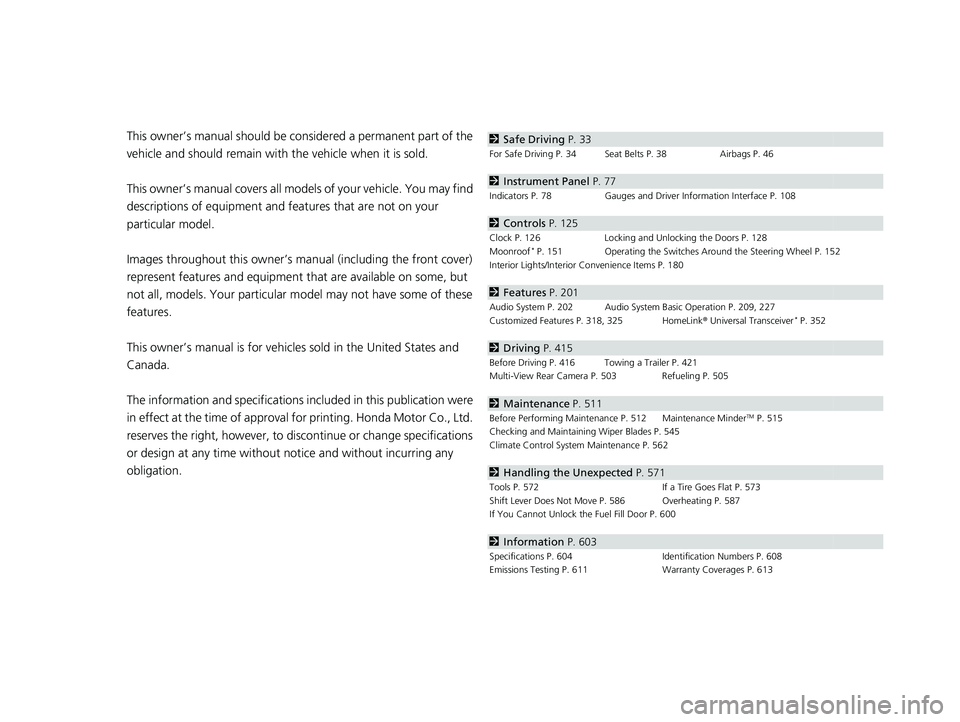
Contents
This owner’s manual should be considered a permanent part of the
vehicle and should remain with the vehicle when it is sold.
This owner’s manual covers all models of your vehicle. You may find
descriptions of equipment and features that are not on your
particular model.
Images throughout this owner’s manu al (including the front cover)
represent features and equipment that are available on some, but
not all, models. Your particular mo del may not have some of these
features.
This owner’s manual is for vehicles sold in the United States and
Canada.
The information and specifications in cluded in this publication were
in effect at the time of approval for printing. Honda Motor Co., Ltd.
reserves the right, however, to discontinue or change specifications
or design at any time without notice and without incurring any
obligation.2 Safe Driving P. 33
For Safe Driving P. 34 Seat Belts P. 38 Airbags P. 46
2Instrument Panel P. 77
Indicators P. 78 Gauges and Driver Information Interface P. 108
2Controls P. 125
Clock P. 126 Locking and Unlocking the Doors P. 128
Moonroof* P. 151 Operating the Switches Around the Steering Wheel P. 152
Interior Lights/Interior Convenience Items P. 180
2 Features P. 201
Audio System P. 202 Audio System Basic Operation P. 209, 227
Customized Features P. 318, 325 HomeLink ® Universal Transceiver* P. 352
2 Driving P. 415
Before Driving P. 416 Towing a Trailer P. 421
Multi-View Rear Camera P. 503 Refueling P. 505
2Maintenance P. 511
Before Performing Maintenance P. 512 Maintenance MinderTM P. 515
Checking and Maintaining Wiper Blades P. 545
Climate Control System Maintenance P. 562
2Handling the Unexpected P. 571
Tools P. 572 If a Tire Goes Flat P. 573
Shift Lever Does Not Move P. 586 Overheating P. 587
If You Cannot Unlock the Fuel Fill Door P. 600
2 Information P. 603
Specifications P. 604 Identification Numbers P. 608
Emissions Testing P. 611 Warranty Coverages P. 613
21 CIVIC 4D HCM_HMIN_J (KA KL KC)-31TBA6500.book 4 ページ 2020年8月25日 火曜日 午後2時6分
Page 8 of 632
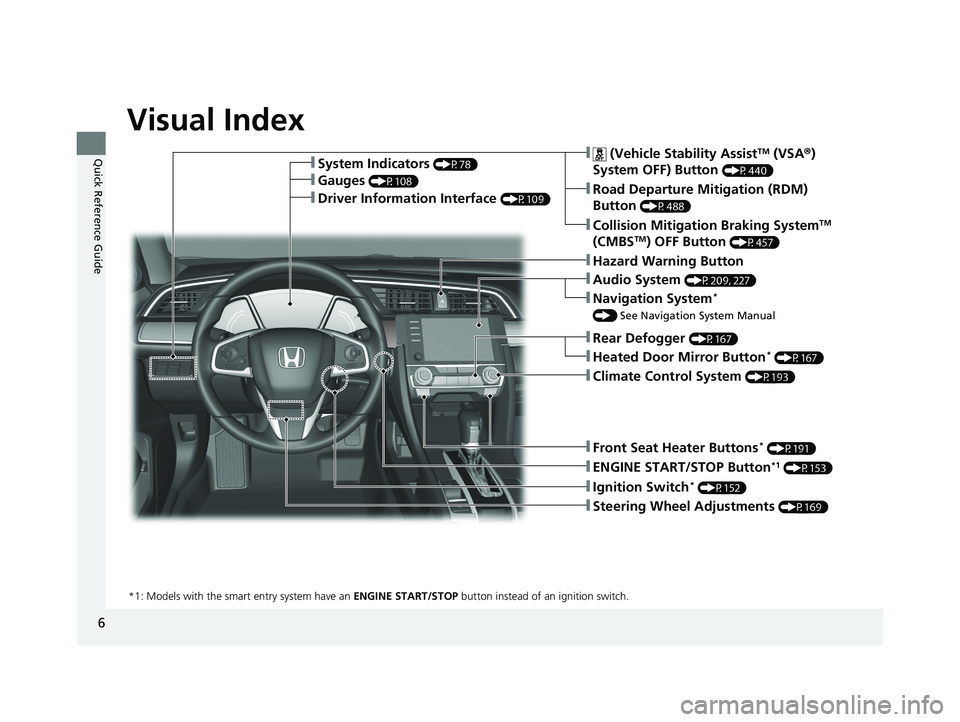
6
Quick Reference Guide
Quick Reference Guide
Visual Index
❚Ignition Switch* (P152)
❚ENGINE START/STOP Button*1 (P153)
*1: Models with the smart entry system have an ENGINE START/STOP button instead of an ignition switch.
❚System Indicators (P78)
❚Gauges (P108)
❚ (Vehicle Stability AssistTM (VSA®)
System OFF) Button
(P440)
❚Road Departure Mitigation (RDM)
Button
(P488)
❚Navigation System*
() See Navigation System Manual
❚Audio System (P209, 227)
❚Hazard Warning Button
❚Rear Defogger (P167)
❚Heated Door Mirror Button* (P167)
❚Front Seat Heater Buttons* (P191)
❚Steering Wheel Adjustments (P169)
❚Driver Information Interface (P109)
❚Collision Mitigation Braking SystemTM
(CMBSTM) OFF Button (P457)
❚Climate Control System (P193)
21 CIVIC 4D HCM_HMIN_J (KA KL KC)-31TBA6500.book 6 ページ 2020年8月25日 火曜日 午後2時6分
Page 14 of 632
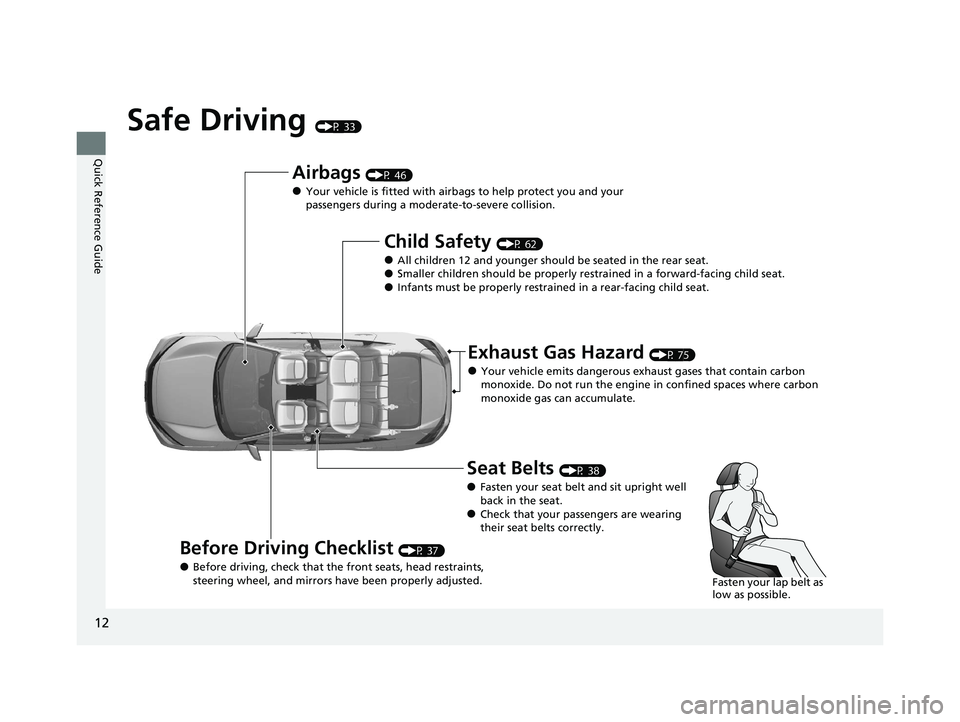
12
Quick Reference Guide
Safe Driving (P 33)
Airbags (P 46)
●Your vehicle is fitted with airbags to help protect you and your
passengers during a moderate-to-severe collision.
Child Safety (P 62)
●All children 12 and younger should be seated in the rear seat.●Smaller children should be properly restrained in a forward-facing child seat.●Infants must be properly restrained in a rear-facing child seat.
Exhaust Gas Hazard (P 75)
●Your vehicle emits dangerous exhaust gases that contain carbon
monoxide. Do not run the engine in confined spaces where carbon
monoxide gas can accumulate.
Before Driving Checklist (P 37)
●Before driving, check that the front seats, head restraints,
steering wheel, and mirrors have been properly adjusted.
Seat Belts (P 38)
●Fasten your seat belt and sit upright well
back in the seat.
●Check that your passengers are wearing
their seat belts correctly.
Fasten your lap belt as
low as possible.
21 CIVIC 4D HCM_HMIN_J (KA KL KC)-31TBA6500.book 12 ページ 2020年8月25日 火曜日 午後2時6分
Page 18 of 632
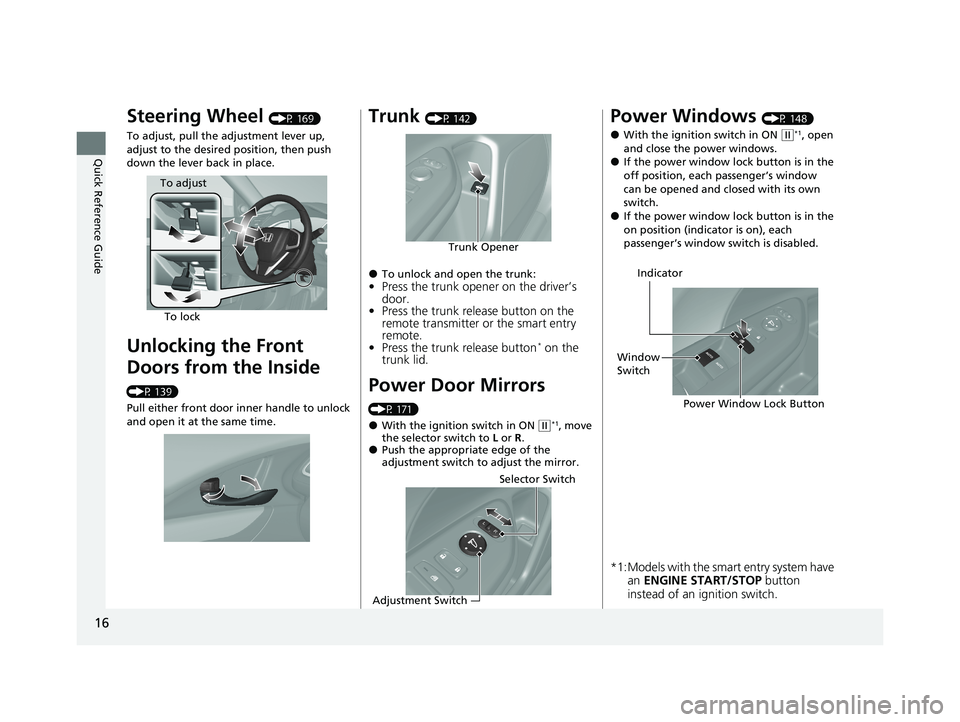
16
Quick Reference Guide
Steering Wheel (P 169)
To adjust, pull the adjustment lever up,
adjust to the desired position, then push
down the lever back in place.
Unlocking the Front
Doors from the Inside
(P 139) Pull either front door inner handle to unlock
and open it at the same time.
To adjust
To lock
Trunk (P 142)
●To unlock and open the trunk:• Press the trunk opener on the driver’s
door.
• Press the trunk release button on the
remote transmitter or the smart entry
remote.
• Press the trunk release button
* on the
trunk lid.
Power Door Mirrors
(P 171)
●With the ignition switch in ON ( w*1, move
the selector switch to L or R .
●Push the appropriate edge of the
adjustment switch to adjust the mirror.
Trunk Opener
Selector Switch
Adjustment Switch
Power Windows (P 148)
●With the ignition switch in ON ( w*1, open
and close the power windows.
●If the power window lock button is in the
off position, each passenger’s window
can be opened and closed with its own
switch.
●If the power window lock button is in the
on position (indicator is on), each
passenger’s window switch is disabled.
*1:Models with the sma rt entry system have
an ENGINE START/STOP button
instead of an ignition switch.
Power Window Lock Button
Window
Switch Indicator
21 CIVIC 4D HCM_HMIN_J (KA KL KC)-31TBA6500.book 16 ページ 2020年8月25日 火曜日 午後2時6分
Page 26 of 632
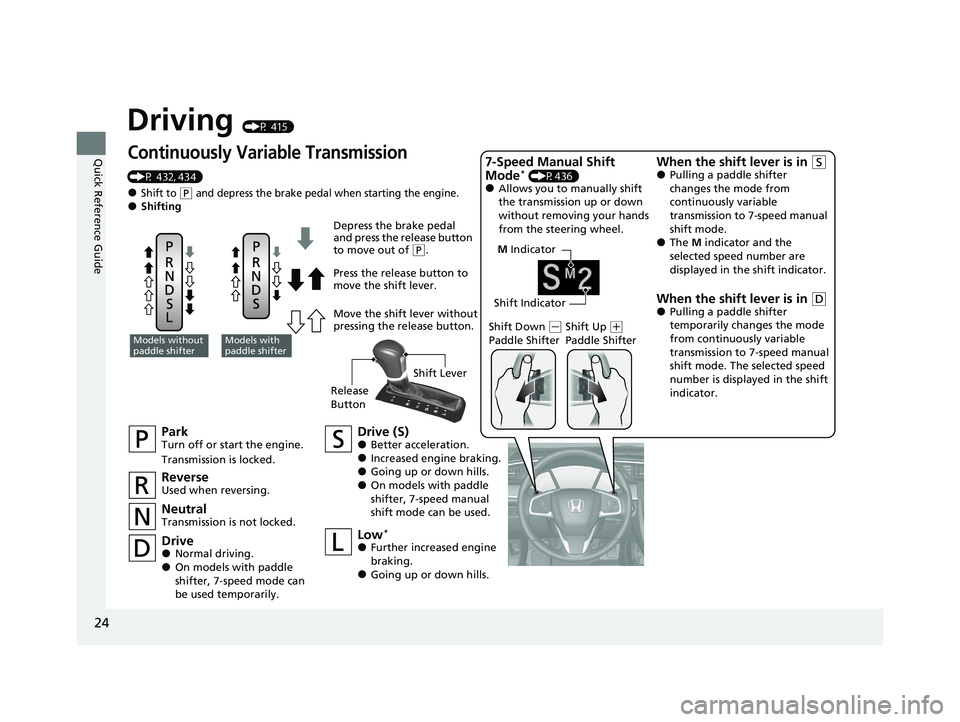
24
Quick Reference Guide
Driving (P 415)
Continuously Variable Transmission
(P 432, 434)
●Shift to (P and depress the brake pedal when starting the engine.●Shifting
M Indicator
Shift Indicator
ParkTurn off or start the engine.
Transmission is locked.
NeutralTransmission is not locked.
Drive (S)●Better acceleration.●Increased engine braking.●Going up or down hills.●On models with paddle
shifter, 7-speed manual
shift mode can be used.
Models without
paddle shifterModels with
paddle shifter
Depress the brake pedal
and press the release button
to move out of
( P.
Press the release button to
move the shift lever.
Move the shift lever without
pressing the release button.
ReverseUsed when reversing.
Drive●Normal driving.●On models with paddle
shifter, 7-speed mode can
be used temporarily.
Low*
●Further increased engine
braking.
●Going up or down hills. Shift Down
(
-
Paddle Shifter Shift Up (
+
Paddle Shifter
7-Speed Manual Shift
Mode* (P436)●Allows you to manually shift
the transmission up or down
without removing your hands
from the steering wheel.
When the shift lever is in (S●Pulling a paddle shifter
changes the mode from
continuously variable
transmission to 7-speed manual
shift mode.
●The M indicator and the
selected speed number are
displayed in the shift indicator.
When the shift lever is in (D●Pulling a paddle shifter
temporarily chan ges the mode
from continuously variable
transmission to 7-speed manual
shift mode. The selected speed
number is displayed in the shift
indicator.
Release
Button Shift Lever
21 CIVIC 4D HCM_HMIN_J (KA KL KC)-31TBA6500.book 24 ページ 2020年8月25日 火曜日 午後2時6分
Page 30 of 632
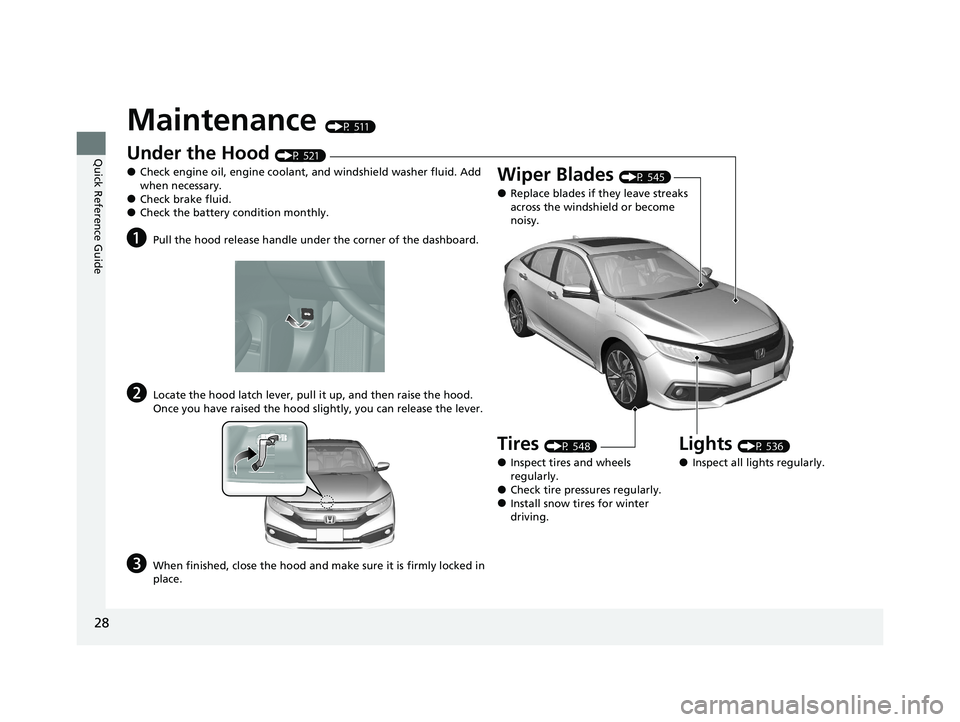
28
Quick Reference Guide
Maintenance (P 511)
Under the Hood (P 521)
●Check engine oil, engine coolant, and windshield washer fluid. Add
when necessary.
●Check brake fluid.●Check the battery condition monthly.
aPull the hood release handle under the corner of the dashboard.
bLocate the hood latch lever, pull it up, and then raise the hood.
Once you have raised the hood slightly, you can release the lever.
cWhen finished, close the hood and make sure it is firmly locked in
place.
Lights (P 536)
●Inspect all lights regularly.
Wiper Blades (P 545)
●Replace blades if they leave streaks
across the windshield or become
noisy.
Tires (P 548)
●Inspect tires and wheels
regularly.
●Check tire pressures regularly.●Install snow tires for winter
driving.
21 CIVIC 4D HCM_HMIN_J (KA KL KC)-31TBA6500.book 28 ページ 2020年8月25日 火曜日 午後2時6分
Page 32 of 632
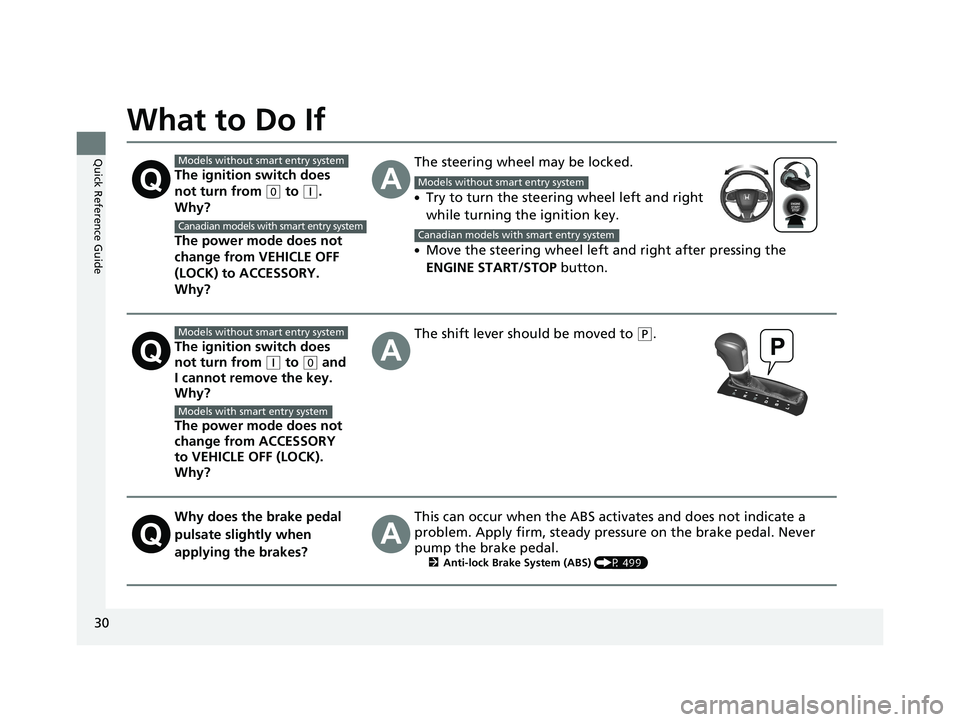
30
Quick Reference Guide
What to Do If
The ignition switch does
not turn from
(0 to (q.
Why?
The power mode does not
change from VEHICLE OFF
(LOCK) to ACCESSORY.
Why?
The steering wheel may be locked.
●Try to turn the steering wheel left and right
while turning the ignition key.
●Move the steering wheel left and right after pressing the
ENGINE START/STOP button.
The ignition switch does
not turn from
(q to (0 and
I cannot remove the key.
Why?
The power mode does not
change from ACCESSORY
to VEHICLE OFF (LOCK).
Why?
The shift lever should be moved to (P.
Why does the brake pedal
pulsate slightly when
applying the brakes?This can occur when the ABS activates and does not indicate a
problem. Apply firm, steady pressure on the brake pedal. Never
pump the brake pedal.
2 Anti-lock Brake System (ABS) (P 499)
Models without smart entry system
Canadian models with smart entry system
Models without smart entry system
Canadian models with smart entry system
Models without smart entry system
Models with smart entry system
21 CIVIC 4D HCM_HMIN_J (KA KL KC)-31TBA6500.book 30 ページ 2020年8月25日 火曜日 午後2時6分
Page 49 of 632
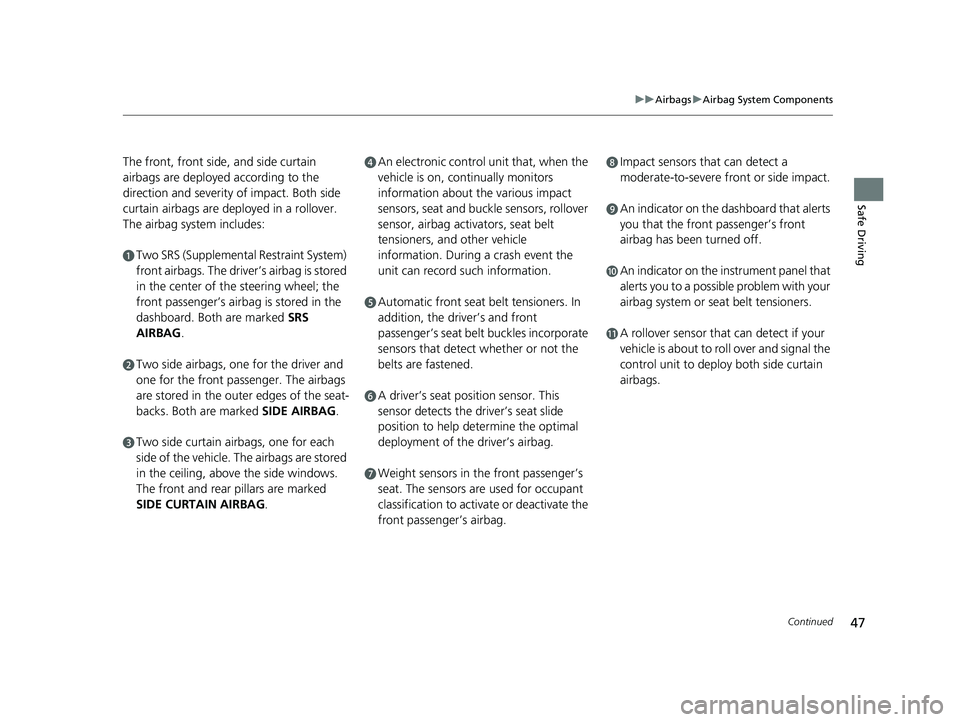
47
uuAirbags uAirbag System Components
Continued
Safe Driving
The front, front side, and side curtain
airbags are deployed according to the
direction and severity of impact. Both side
curtain airbags are deployed in a rollover.
The airbag system includes:
aTwo SRS (Supplemental Restraint System)
front airbags. The driver’s airbag is stored
in the center of the steering wheel; the
front passenger’s airbag is stored in the
dashboard. Both are marked SRS
AIRBAG.
bTwo side airbags, one for the driver and
one for the front passenger. The airbags
are stored in the outer edges of the seat-
backs. Both are marked SIDE AIRBAG.
cTwo side curtain ai rbags, one for each
side of the vehicle. The airbags are stored
in the ceiling, abov e the side windows.
The front and rear pillars are marked
SIDE CURTAIN AIRBAG .
dAn electronic control unit that, when the
vehicle is on, continually monitors
information about the various impact
sensors, seat and buckle sensors, rollover
sensor, airbag activators, seat belt
tensioners, and other vehicle
information. During a crash event the
unit can record such information.
eAutomatic front seat belt tensioners. In
addition, the driver’s and front
passenger’s seat belt buckles incorporate
sensors that detect whether or not the
belts are fastened.
fA driver’s seat position sensor. This
sensor detects the driver’s seat slide
position to help determine the optimal
deployment of the driver’s airbag.
gWeight sensors in the front passenger’s
seat. The sensors are used for occupant
classification to activate or deactivate the
front passenger’s airbag.
hImpact sensors that can detect a
moderate-to-severe front or side impact.
iAn indicator on the dashboard that alerts
you that the front passenger’s front
airbag has been turned off.
jAn indicator on the instrument panel that
alerts you to a possib le problem with your
airbag system or seat belt tensioners.
kA rollover sensor that can detect if your
vehicle is about to ro ll over and signal the
control unit to deploy both side curtain
airbags.
21 CIVIC 4D HCM_HMIN_J (KA KL KC)-31TBA6500.book 47 ページ 2020年8月25日 火曜日 午後2時6分
Page 50 of 632
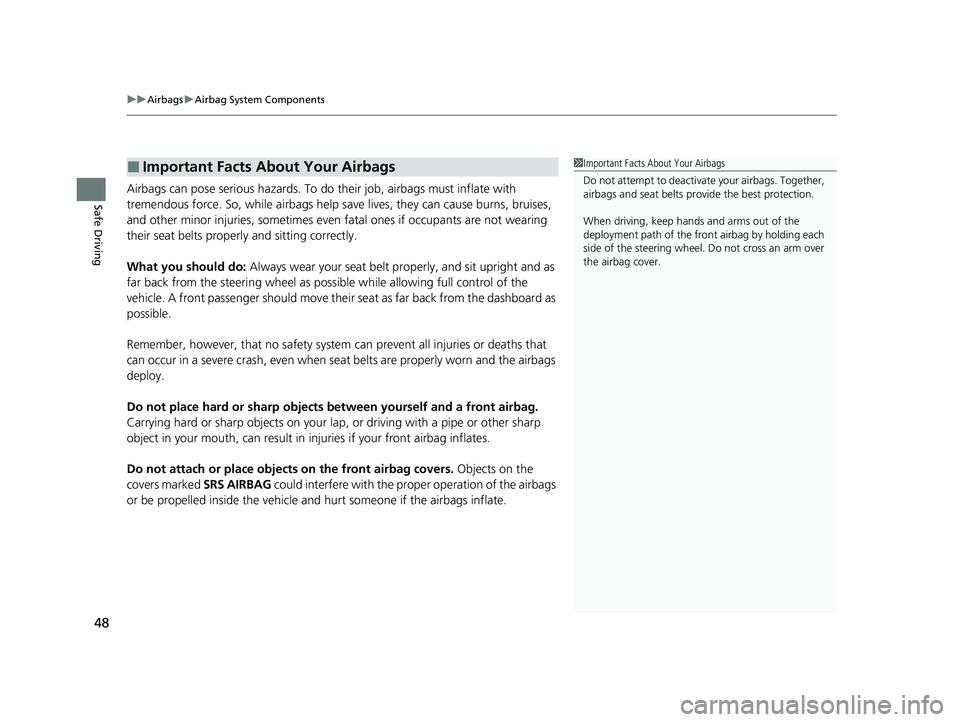
uuAirbags uAirbag System Components
48
Safe DrivingAirbags can pose serious hazards. To do their job, airbags must inflate with
tremendous force. So, while airbags help save lives, they can cause burns, bruises,
and other minor injuries, sometimes even fatal ones if occupants are not wearing
their seat belts properly and sitting correctly.
What you should do: Always wear your seat belt properly, and sit upright and as
far back from the steering wheel as possi ble while allowing full control of the
vehicle. A front passenger should move their seat as far back from the dashboard as
possible.
Remember, however, that no safety system can prevent all injuries or deaths that
can occur in a severe crash, even when seat belts are properly worn and the airbags
deploy.
Do not place hard or sharp objects between yourself and a front airbag.
Carrying hard or sharp objects on your lap, or driving with a pipe or other sharp
object in your mouth, can result in in juries if your front airbag inflates.
Do not attach or place object s on the front airbag covers. Objects on the
covers marked SRS AIRBAG could interfere with the proper operation of the airbags
or be propelled inside the vehicle an d hurt someone if the airbags inflate.
■Important Facts About Your Airbags1Important Facts About Your Airbags
Do not attempt to deactivate your airbags. Together,
airbags and seat belts pr ovide the best protection.
When driving, keep hands and arms out of the
deployment path of the fro nt airbag by holding each
side of the steering wheel. Do not cross an arm over
the airbag cover.
21 CIVIC 4D HCM_HMIN_J (KA KL KC)-31TBA6500.book 48 ページ 2020年8月25日 火曜日 午後2時6分
Page 51 of 632
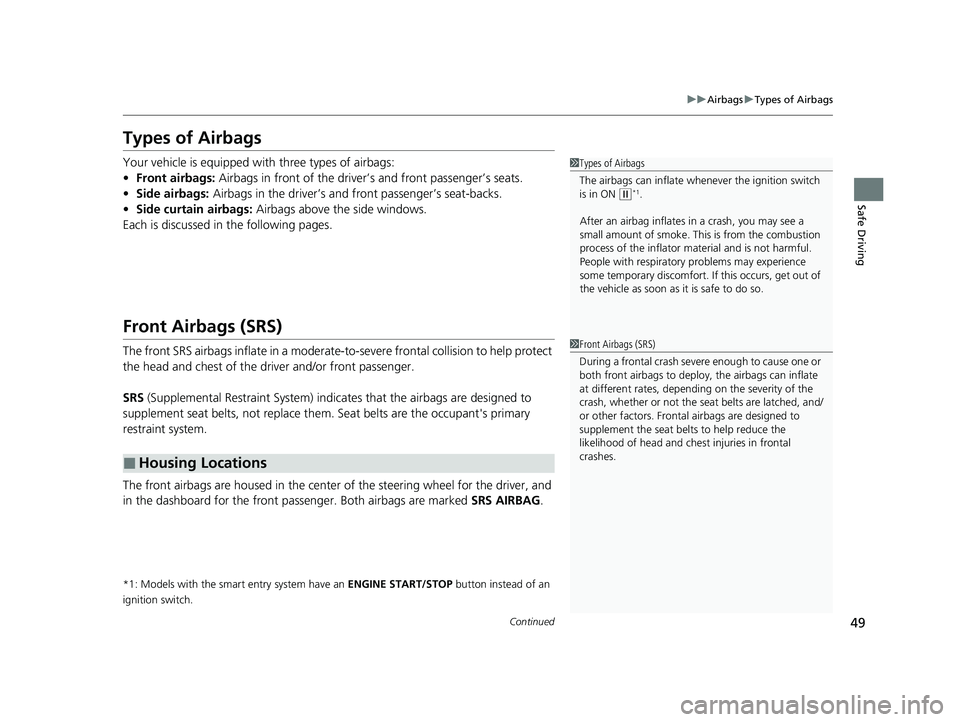
49
uuAirbags uTypes of Airbags
Continued
Safe Driving
Types of Airbags
Your vehicle is equipped wi th three types of airbags:
• Front airbags: Airbags in front of the driver’s and front passenger’s seats.
• Side airbags: Airbags in the driver’s and front passenger’s seat-backs.
• Side curtain airbags: Airbags above the side windows.
Each is discussed in the following pages.
Front Airbags (SRS)
The front SRS airbags inflate in a moderate-to-severe frontal collision to help protect
the head and chest of the driver and/or front passenger.
SRS (Supplemental Restraint System) indica tes that the airbags are designed to
supplement seat belts, not replace them . Seat belts are the occupant's primary
restraint system.
The front airbags are housed in the center of the steering wheel for the driver, and
in the dashboard for the front pass enger. Both airbags are marked SRS AIRBAG.
*1: Models with the smart entry system have an ENGINE START/STOP button instead of an
ignition switch.
■Housing Locations
1 Types of Airbags
The airbags can inflate whenever the ignition switch
is in ON
(w*1.
After an airbag inflates in a crash, you may see a
small amount of smoke. This is from the combustion
process of the infl ator material and is not harmful.
People with respiratory pr oblems may experience
some temporary discomfort. If this occurs, get out of
the vehicle as soon as it is safe to do so.
1 Front Airbags (SRS)
During a frontal crash severe enough to cause one or
both front airbags to deploy, the airbags can inflate
at different rates, dependi ng on the severity of the
crash, whether or not the se at belts are latched, and/
or other factors. Frontal airbags are designed to
supplement the seat belts to help reduce the
likelihood of head and chest injuries in frontal
crashes.
21 CIVIC 4D HCM_HMIN_J (KA KL KC)-31TBA6500.book 49 ページ 2020年8月25日 火曜日 午後2時6分